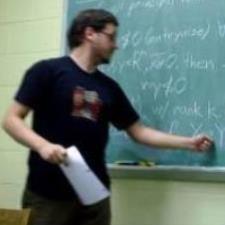
Michael B. answered • 11/14/14
Tutor
4.9
(55)
Effective and Knowledgeable Math Tutor for Calculus and Statistics
x*y'+2y-6x=0 is NOT an exact equation, because dN/dx =/= dM/dy (using d for partial derivative)
it can be made exact by multiplying both sides of the equation by x again, however
x2y' +2yx - 6x2 = 0 is an exact equation that is equivalent to your equation, because dN/dx = dM/dy
i.e. d(x2)/dx = d(2xy-6x2)/dy = 2x
how did I know to multiply by x? I used the integrating factor method:
any equation of the form y'+f(x)y=g(x) has an integrating factor that will make it exact of the form e^antidirevative(f(x))
which for y'(x)+2y(x)/x=6 ( f(x) = 2/x g(x) = 6) is e^antidirevative(2/x)
= e^(2*ln(x))
=e^ln(x^2)
=x^2
we had already multiplied by x once, so i did it again to simulate multiplying by x^2
from here, you might have been taught the formula for integrating factor method:
y = 1/u*antidirevative(g*u) where g is 6 and u is our factor x2
you can solve using that formula (just don't forget the constant of integration when you take the antidirevative)
or you can solve using the method to solve exact equations:
some w(x,y) must exist such that pw/py*dy + pw/px*dx = dw = 0 (in layman's terms, there must be a path on a surface in 3 dimensions (w,x,y) such that change in the w direction is 0 (constant value for w). This is called a characteristic curve)
compare that to x2y' +2yx - 6x2 = 0
can be written x^2*dy/dx +2yx - 6x^2 = 0
(x^2)*dy +(2yx - 6x^2)*dx = 0
(pw/py)*dy + (pw/px)*dx = 0 (p is partial, d is ordinary)
so treat pw/py = x^2
pw/px = 2yx - 6x^2
partially integrate both you get
w = y*x^2 + c(x) // c and d are like constants of integration, but for multiple variables
w = y*x^2 - 2*x^3 + d(y) // if you where to take the partial derivative with respect to x, any function of y
// would disappear
w must be constant, for it is a characteristic curve, and must satisfy both of those equations, this works:
w = y*x^2 - 2*x^3 = constant
substituting your condition y(-2)=-4
constant = 0
so your solution is y*x^2 - 2*x^3 =0 can be simplified
y=2*x
all that work for such a simple solution
you can plug back in to verify:
y'(x)+2y(x)/x=6
2+4x/x = 6
6=6
hooray
the method to solve exact equations can be used to get the formula for the integrating factor method, in case your wondering. the equation for the integrating factor can be derived by multiplying both sides of the equation by an unknown function of x, and then solving for that function by setting dN/dx = dM/dy
I suspect all your teacher wanted was for you to memorize:
if y'+f(x)y=g(x)
u = e^antidirevative(f(x))
y = 1/u*antidirevative(g*u)
solving this way;
y'+2y/x=6
u = e^antidirevative(2/x) = x^2
y = 1/u*antidirevative(g*u) = x^-2*antidirevative(6*x^2)
y=x^-2*(2*x^3+c)
y(-2)=-4 so c=0
y=2*x
hopefully you followed this to the end and learned math. Please ask for any clarification.





